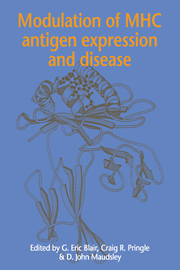Book contents
- Frontmatter
- Contents
- List of contributors
- Preface
- List of abbreviations
- 1 General introduction to the MHC
- 2 Organization of the MHC
- 3 Interactions of cytokines in the regulation of MHC class I and class II antigen expression
- 4 Control of MHC class I gene expression
- 5 Control of MHC class II gene expression
- 6 Modulation of MHC antigen expression by viruses
- 7 Modulation of MHC antigen expression by retroviruses
- 8 Modulation of MHC class I antigen expression in adenovirus infection and transformation
- 9 MHC expression in HPV-associated cervical cancer
- 10 Inhibition of the cellular response to interferon by hepatitis B virus polymerase
- 11 Cellular adhesion molecules and MHC antigens in cells infected with Epstein-Barr virus: implications for immune recognition
- 12 Effect of human cytomegalovirus infection on the expression of MHC class I antigens and adhesion molecules: potential role in immune evasion and immunopathology
- 13 Oncogenes and MHC class I expression
- 14 Mechanisms of tumour cell killing and the role of MHC antigens in experimental model systems
- 15 Manipulation of MHC antigens by gene transfection and cytokine stimulation: a possible approach for pre-selection of suitable patients for cytokine therapy
- 16 Overexpression of MHC proteins in pancreatic islets: a link between cytokines, viruses, the breach of tolerance and insulindependent diabetes mellitus?
- 17 The role of cytokines in contributing to MHC antigen expression in rheumatoid arthritis
- 18 Expression of an MHC antigen in the central nervous system: an animal model for demyelinating diseases
- Index
1 - General introduction to the MHC
Published online by Cambridge University Press: 11 September 2009
- Frontmatter
- Contents
- List of contributors
- Preface
- List of abbreviations
- 1 General introduction to the MHC
- 2 Organization of the MHC
- 3 Interactions of cytokines in the regulation of MHC class I and class II antigen expression
- 4 Control of MHC class I gene expression
- 5 Control of MHC class II gene expression
- 6 Modulation of MHC antigen expression by viruses
- 7 Modulation of MHC antigen expression by retroviruses
- 8 Modulation of MHC class I antigen expression in adenovirus infection and transformation
- 9 MHC expression in HPV-associated cervical cancer
- 10 Inhibition of the cellular response to interferon by hepatitis B virus polymerase
- 11 Cellular adhesion molecules and MHC antigens in cells infected with Epstein-Barr virus: implications for immune recognition
- 12 Effect of human cytomegalovirus infection on the expression of MHC class I antigens and adhesion molecules: potential role in immune evasion and immunopathology
- 13 Oncogenes and MHC class I expression
- 14 Mechanisms of tumour cell killing and the role of MHC antigens in experimental model systems
- 15 Manipulation of MHC antigens by gene transfection and cytokine stimulation: a possible approach for pre-selection of suitable patients for cytokine therapy
- 16 Overexpression of MHC proteins in pancreatic islets: a link between cytokines, viruses, the breach of tolerance and insulindependent diabetes mellitus?
- 17 The role of cytokines in contributing to MHC antigen expression in rheumatoid arthritis
- 18 Expression of an MHC antigen in the central nervous system: an animal model for demyelinating diseases
- Index
Summary
Introduction
To protect the individual from foreign agents, such as viruses and bacteria, mammals have evolved a sophisticated system that allows them to distinguish self from non-self. Self/non-self discrimination was first demonstrated in mammals by the rejection of foreign tissue grafts in mice (Gorer, 1936; Snell, 1958; Klein, 1975). The genetic loci involved in graft rejection were subsequently mapped to a region on chromosome 17 (Klein, 1975), which became known as the major histocompatibility complex (MHC). The human MHC, also known as the human leukocyte antigen (HLA) system, is located on chromosome 6 (van Someren et al, 1974).
The MHC occupies some 3.5 megabase pairs (Mb) of the genome and, in humans, approximately 75 genes (many still of unknown function) have been identified in this region (Trowsdale, Ragoussis & Campbell, 1991). The organization of the MHC is reviewed in detail in Chapter 2. The complex is often divided into three different classes of gene: I, II and III. There are multiple class I loci but the classical ‘transplantation antigens’ fall into three positions termed HLA-A, HLA-B and HLA-C in humans. The class II genes, encoded in the HLA-D region, encode proteins that help regulate the immune response to different antigens (Fig. 1.1). In early experiments that studied the genetic control of immunity to certain protein antigens, the immune response, whether strong or weak, was found to depend on particular alleles at loci within the MHC.
- Type
- Chapter
- Information
- Modulation of MHC Antigen Expression and Disease , pp. 1 - 26Publisher: Cambridge University PressPrint publication year: 1995
- 3
- Cited by



